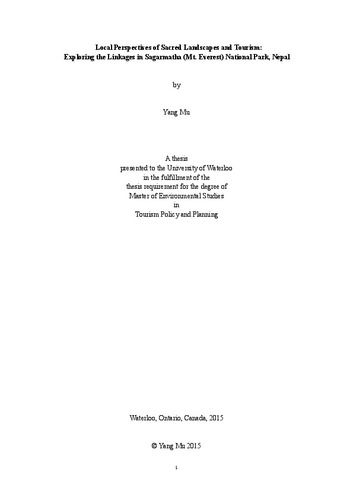| dc.description.abstract | Many cultures around the world attach sacred values to natural and cultural sites. Although
different cultures interpret the word “sacred” differently, sacred places generally reveal strict
behavioural restrictions, a sense of separateness (Hubert, 1997), as well as strong
emotion-oriented and place-bound characteristics (Levi & Kocher, 2013). However, the
concept of sacred landscape appears to be a vague one, and is not fully examined in existing
literature. As many sacred places turn into popular tourist destinations, the environmental,
economic and social implications of tourism to such destinations require deeper
understandings of tourism’s role in reshaping spiritual values and reproducing local
perceptions of the “sacred”.
This study examines local residents’ objective recognition and subjective interpretations of a
sacred landscape, and how these are influenced by tourism development. The Sagarmatha
(Mt. Everest) National Park (SNP) in Nepal’s Khumbu Region was selected as the case study
area. The region is perceived as a sacred beyul (hidden valley) by local Buddhist Sherpas, and
has undergone tremendous environmental, economic and social changes brought by trekking
tourism. This study is exploratory in nature, and is based on author’s field observation and 33
in-depth, semi-structured interviews conducted with Sherpa residents during fall 2014.
Study findings indicate that Sherpa residents’ objective recognition of sacred landscape are
influenced by geographical proximity to sacred sites, age of residents, and their religious
background. Subjective interpretations of sacred landscape are shaped by a strong awareness
of the behavioural restrictions, family influence, as well as personal experiences. Sherpas’
emotional and spiritual bonds with the landscape are reinforced through routinized contact
with the sacred cultural features, and consistent compliance with the rules of conduct at
sacred sites. Through everyday practices, Sherpas unconsciously remind themselves about the
spiritual values and religious beliefs embedded in the landscape. Sherpas are actively
engaged in activities such as religious festivals which promote their cultural identity and
spirits. Tourism’s influence on local spiritual values is evident and reflected in three aspects:
changes in mountain deity worship; shift in human-land relationship; and, alterations of
religious routines and practices. Tourism development has made beyul Khumbu a hybrid and
dynamic place, where traditional spiritual values and religious practices exist simultaneously
with increased commercialization and modernization due to tourism. Although Sherpas still
regard Khumbu as a sacred place and are actively focused on retaining the essential
components of Sherpa spiritual values and cultural identity, the religious influence of beyul is
slowly declining as people’s life drift away from the land, and interests shift to material
consumption.
This research aims to make contributions to the existing literature on landscape studies and
cultural geography by examining local residents’ perceptions toward multiple aspects of a
sacred landscape under changing social and economic contexts. Also, exploring the changing
indigenous spiritual values and religious beliefs will help developing more sustainable and
effective management policies in cultural and environmental conservation. | en |

